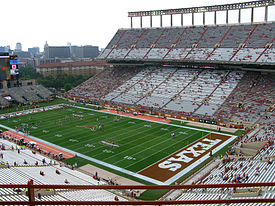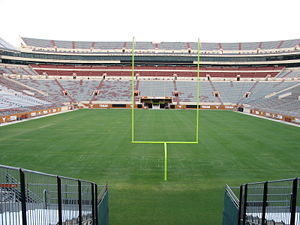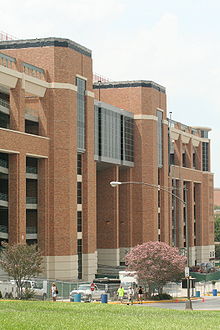- Darrell K Royal
-
Darrell K Royal – Texas Memorial Stadium "DKR" 
Former names Memorial Stadium
Texas Memorial StadiumLocation 405 East 23rd Street
Austin, TX 78712Coordinates 30°17′1″N 97°43′57″W / 30.28361°N 97.7325°WCoordinates: 30°17′1″N 97°43′57″W / 30.28361°N 97.7325°W Broke ground 1924 Opened November 8, 1924 (first game)
November 27, 1924 (dedication)[1]Renovated 1999, 2008 Expanded 1926, 1948, 1971, 1998, 2006-2009 Owner University of Texas Operator University of Texas Surface FieldTurf (2009–Present)
Natural grass (1996–2008)
Artificial turf (1969–1995)
Natural grass (1924–1968)Construction cost $275,000[2]
($3.53 million in 2011 dollars[3])Architect Herbert M. Greene General Contractor Walsh and Burney[4] Capacity 27,000 (1924-1925)
40,500 (1926-1947)
60,130 (1948-1970)
77,809 (1971-1997)
79,471 (1998)
80,092 (1999-2005)
85,123 (2006-2007)
94,113 (2008)
100,119 (2009-present)Record attendance 101,624
September 3, 2011
vs. Rice UniversityTenants Texas Longhorns (NCAA) (1924–present) Darrell K Royal – Texas Memorial Stadium (formerly War Memorial Stadium, Memorial Stadium, and Texas Memorial Stadium), located in Austin, Texas, has been home to the University of Texas Longhorns football team since 1924. The stadium has delivered a great home field advantage with the team's home record through the 2010 season being 344-95-10 (77.9%).[5] The current official stadium seating capacity of 100,119[1] makes the stadium the largest football-only venue by seating capacity in the state of Texas, the largest in the Big 12 Conference, the sixth largest stadium in the NCAA and the United States, and the ninth largest non-racing stadium in the world.
While DKR-Texas Memorial Stadium has the largest seating capacity in the state of Texas, the NFL Dallas Cowboys' new stadium, Cowboys Stadium, has an overall capacity of 111,000 due to a seating capacity of 80,000 plus party plazas capable of accommodating up to 31,000 standing spectators.
The DKR-Texas Memorial Stadium attendance record of 101,624 spectators was set on September 3, 2011, when Texas defeated Rice University, 34-9.
The stadium has been expanded several times since its original opening. The University's most recent project, a $27 million expansion and renovation project to the south end zone facilities, was completed in August 2009. For the 2009 season, 4,525 permanent bleacher seats were constructed, which allowed the stadium to become the first football stadium in Texas capable of seating in excess of 100,000 persons[6] and brought the stadium to its current seating capacity.
Contents
Memorial Dedication
In 1923, former UT athletics director L. Theo Bellmont (the west side of the stadium is named in his honor), along with thirty student leaders, presented the idea of building a concrete stadium to replace the wooden bleachers of Clark Field to the Board of Regents. Heralded as "the largest sports facility of its kind in the Southwest" upon its completion in 1924, the first unit of the stadium consisted of the east and west stands with a seating capacity of 27,000. It was designed as a dual-purpose facility with a 440-yard (400 m) track surrounding the football field. The stadium was financed through donations from both students and alumni. The estimated cost of the structure was $275,000.
The student body dedicated the stadium in honor of the 198,520 Texans — 5,280 of whom lost their lives — who fought in World War I. A statue, representing the figure of democracy, was later placed atop the north end zone seats of the stadium. In World War II, the University lost many former players, including former coach Jack Chevigny. The Athletics Council rededicated the newly enlarged stadium on September 18, 1948 prior to the Texas-LSU game, honoring the men and women who had died in the war. On November 12, 1977, a small granite monument was unveiled and placed at the base of the statue, during the TCU-Texas game. The ceremony rededicated Texas Memorial Stadium to the memory of all alumni in all American wars.
The University of Texas honored legendary football coach Darrell K Royal, who never served, but did lead Texas to three national championships and eleven Southwest Conference titles, by officially naming the stadium after him in 1996. Additionally, the University established the Royal-Texas Memorial Stadium Veterans Committee, composed of alumni who served in World War II, Korea, Vietnam or the Gulf Wars. The committee is charged to forever dedicate the stadium in the memory of, and in honor of, UT students and alumni who gave their lives for their country. Each year, one home football game is designated as Veterans Recognition Day, commemorating the memorial aspect of the stadium and to honor the memory of war soldiers.
A panorama of the game between the 2005 National Champions and Colorado on October 15, 2005; Texas won 42-17.
Smokey the Cannon (lower left) is in the eastern section of the north end zone. The 2007 expansion brought the seats closer to the field
so the cannon was relocated to the southeastern corner of the stadium.Major Expansions and Renovations
- 1926 - "Horseshoe" built on the north end for US$125,000 raising capacity to 40,500
- 1948 - Two L-shaped sections added to the east and west stands, raising seating capacity to 60,130. General contractor for this work was Farnsworth & Chambers Inc. of Houston, Texas.
- 1955 - Lights added
- 1969 - Upper deck added to the west side raising seating capacity to 75,504 when completed in 1972; artificial turf applied to field. General contractor for this work was a joint venture of two companies — Darragh & Lyda Inc. of San Antonio, Texas and H. A. Lott, Inc. of Houston, Texas.
- 1977 - Track converted from 440 yards to 400 meters (437.4 yds.)
- 1986 - The Vernon F. "Doc" Neuhaus–Darrell K Royal Athletic Center completed at the south end of the stadium at a cost of $7 million; the Center was later renamed the W. A. "Tex" Moncrief, Jr.–V. F. "Doc" Neuhaus Athletic Center in 1997 after Royal's name was added to the stadium
- 1996 - Replacement of the stadium's artificial turf with natural grass (Prescription Athletic Turf); installation of a Jumbotron video system; scoreboards retrofitted
- 1997 - Fourteen stadium suites added to west side; underside of the stands remodeled, adding a concession plaza and visitors' locker room. In recognition of UT law school alumnus and benefactor Joe Jamail, the University named the football playing field Joe Jamail Field.
- 1998 - 5,000-seat upper deck added on east side including fifty-two new stadium suites and a 13,000-square-foot (1,200 m2) private club room
- 1999 - Track removed; new seats added to the west grandstand and the field was lowered seven feet to accommodate new front-row and field-level seats on the east and west grandstands, bringing capacity to 80,082
- 2002 - Prescription Athletic Turf replaced with TifSport Certified Bermuda grass
- 2005 - Bellmont Hall, located in the west side of the stadium, was upgraded to meet newer safety codes set by the Austin Fire Department, the upper deck structure received new water sealing, and the Centennial Room and eighth-floor press box were expanded at a cost of $15 million.
- 2006 - A 7,370-square-foot (685 m2) high-definition Daktronics LED scoreboard, nicknamed "Godzillatron", located in the south end zone, was installed as the centerpiece of $8 million worth of audio/visual improvements. The six large flag poles that previously displayed the Six Flags Over Texas were replaced by smaller flags located atop the new screen. The sound system was also updated and smaller video boards were installed on the east and west sides of the stadium. Also, 432 club seats were added to the west side and approximately 4,000 bleacher seats were added behind the south end zone expanding official seating capacity to 85,123.
- 2007-2008 - see below
- 2009 - A $27 million project[7] brought a new Football Academic Center, a new Hall of Fame, FieldTurf replaced the TifSport Certified Bermuda grass, and the 4,000 south end temporary bleachers were replaced with the addition of 4,525 permanent bleacher seats bringing capacity to 100,119[6].
2007–2008 Expansion Projects
 Godzillatron and the south end seating as seen from the old north end in 2006.
Godzillatron and the south end seating as seen from the old north end in 2006.
In 2006, regents approved a US$149.9 million expansion plan (later increased to $179 million[8]; includes the $15 million 2006 renovations) to include a new memorial plaza and new north end zone structure that was scheduled for completion in August 2008. The new outdoor plaza at the northwest corner is a memorial to veterans, with (the original 1924) bronze tablet honoring Texas World War I deaths, a monument, landscaping, and new stadium entry gates between two 115-foot (35 m) towers, like those in the east grandstand. The expansion also consisted of replacing the north end zone structure with a multi-level complex that includes additional seats with an upper deck, club space, suites, athletic offices, academic-advising areas and a basement with gym space. Demolition of the old north end zone began on December 8, 2006.[9] This was necessary to move the north end seating closer to the field. Extremely unpredictable weather patterns, which included historic amounts of rainfall for much of the year and sleet and snow in January and April, delayed construction several times. However, construction crews worked 24 hours a day, seven days a week, and much of the new lower deck was ready in time for the first game of the 2007 season[8]. The south end bleacher seating was expanded for the 2007 season to seat approximately 6,400 fans[8].
An upper deck was added to the north end zone in time for the 2008 season and the temporary south end seating was reduced back to 4,000 since the north end zone expansion was complete. The south end zone also became the new seating location of the Longhorn Band beginning in 2008. Overall, the stadium's official seating capacity increased from 85,123 to 94,113[10]. With a current capacity of 100,119, this is the only 100k+ capacity stadium in the U.S. that is not a fully enclosed bowl, with room for continued large expansion in the south end zone area.
Future south end zone expansion
The final planned phase of the stadium's expansion includes the construction of permanent seating and an upper deck in the south end zone, completely enclosing the playing field. The stadium's seating capacity is expected to be between 115,000 and 120,000 once the south end zone is fully enclosed, which would mean DKR-Texas Memorial Stadium would supplant The University of Michigan's Michigan Stadium as the largest football stadium in North America.[11] However, the date of the final construction phase to fully enclose the south end zone has not been set nor have any funds been raised.
Top 10 Largest Crowds
Rank Date Attendance Opponent 1 September 3, 2011 101,624 Rice 2 September 25, 2010 101,437 UCLA 3 November 21, 2009 101,357 Kansas 4 September 11, 2010 101,339 Wyoming 5 September 19, 2009 101,297 Texas Tech 6 October 10, 2009 101,152 Colorado 7 September 26, 2009 101,144 UTEP 8 September 5, 2009 101,096 ULM 9 November 7, 2009 101,003 Central Florida 10 September 10, 2011 100,995 BYU See also
Notes and references
- ^ a b "Darrell K Royal-Texas Memorial Stadium". TexasSports.com. University of Texas at Austin. 2009. http://www.texassports.com/facilities/royal-memorial-stadium.html. Retrieved 11 December 2010.
- ^ http://football.ballparks.com/NCAA/Big12/Texas/newindex.htm
- ^ Consumer Price Index (estimate) 1800–2008. Federal Reserve Bank of Minneapolis. Retrieved December 7, 2010.
- ^ http://www.tshaonline.org/handbook/online/articles/xvd01
- ^ http://www.texassports.com/facilities/royal-memorial-stadium.html
- ^ a b http://www.mackbrown-texasfootball.com/sports/m-footbl/spec-rel/021309aab.html
- ^ http://www.utsystem.edu/FPC/currentProjectSelection.cfm?projectID=1267
- ^ a b c "UT says stadium construction on schedule". Archived from the original on 2007-09-29. http://web.archive.org/web/20070929102614/http://www.statesman.com/sports/content/sports/stories/longhorns/08/01/0801stadium.html. Retrieved 2007-08-01.
- ^ Cabenero, David (11 December 2006). "Improvements to Royal-Texas stadium begin - Project adds more seating, space for archives of physical culture". The Daily Texan. http://www.dailytexanonline.com/news/2006/12/11/TopStories/Improvements.To.RoyalTexas.Stadium.Begin-2531530.shtml. Retrieved 2006-12-11.
- ^ "Utility Infielder: Another stadium set for demolition". San Antonio Express-News. 24 September 2008. http://www.mysanantonio.com/sports/page2/29657234.html. Retrieved 2008-10-20.
- ^ "Magician kept UT-OU at Cotton Bowl". DallasNews.com (Dallas Morning News). April 20, 2007. http://www.dallasnews.com/sharedcontent/dws/spt/colleges/texas/stories/042107dnsposherrington.37809c1.html. Retrieved 2007-10-30.>
Sources
- Darrell K Royal-Texas Memorial Stadium at The Handbook of Texas Online. Retrieved June 16, 2005.
External links
- Darrell K Royal-Texas Memorial Stadium at Mack Brown Texas Football
- Darrell K Royal-Texas Memorial Stadium Timeline at www.Sports-Venue.info
- Microsoft PowerPoint Board of Regents presentation of new construction (also Adobe Acrobat format)
Texas Longhorns football Overview Texas Longhorns • Darrell K Royal-Texas Memorial Stadium • Big 12 Conference • Longhorn NetworkHead coaches Retired numbers #10 Vince Young • #12 Colt McCoy • #20 Earl Campbell • #22 Bobby Layne • #34 Ricky Williams • #60 Tommy NobisCulture Hook 'em Horns • Hex Rally • Longhorn Band • Bevo • Hook 'em (mascot) • Smokey the Cannon • Texas Fight • The Eyes of Texas • Longhorn All-AmericansLore Rivalries Texas Tech (Chancellor's Spurs) • Texas A&M (Lone Star Showdown) • Oklahoma Sooners (Red River Shootout) • Arkansas Razorbacks (The Big Shootout)Seasons (119) 1893 • 1894 • 1895 • 1896 • 1897 • 1898 • 18991900 • 1901 • 1902 • 1903 • 1904 • 1905 • 1906 • 1907 • 1908 • 19091910 • 1911 • 1912 • 1913 • 1914 • 1915 • 1916 • 1917 • 1918 • 19191920 • 1921 • 1922 • 1923 • 1924 • 1925 • 1926 • 1927 • 1928 • 19291930 • 1931 • 1932 • 1933 • 1934 • 1935 • 1936 • 1937 • 1938 • 19391940 • 1941 • 1942 • 1943 • 1944 • 1945 • 1946 • 1947 • 1948 • 19491950 • 1951 • 1952 • 1953 • 1954 • 1955 • 1956 • 1957 • 1958 • 19591960 • 1961 • 1962 • 1963 • 1964 • 1965 • 1966 • 1967 • 1968 • 19691970 • 1971 • 1972 • 1973 • 1974 • 1975 • 1976 • 1977 • 1978 • 19791980 • 1981 • 1982 • 1983 • 1984 • 1985 • 1986 • 1987 • 1988 • 19891990 • 1991 • 1992 • 1993 • 1994 • 1995 • 1996 • 1997 • 1998 • 19992000 • 2001 • 2002 • 2003 • 2004 • 2005 • 2006 • 2007 • 2008 • 20092010 • 2011
Conference Championship • National ChampionshipFootball stadiums of the Big 12 Conference Floyd Casey Stadium (Baylor) • Jack Trice Stadium (Iowa State) • Memorial Stadium (Kansas) • Bill Snyder Family Football Stadium (Kansas State) • Faurot Field (Missouri) • Gaylord Family Oklahoma Memorial Stadium (Oklahoma) • Boone Pickens Stadium (Oklahoma State) • Darrell K Royal – Texas Memorial Stadium (Texas) • Kyle Field (Texas A&M) • Jones AT&T Stadium (Texas Tech)
College football venues in Texas Division I
FBSBig 12 Darrell K Royal – Texas Memorial Stadium (Texas) • Floyd Casey Stadium (Baylor)
Jones AT&T Stadium (Texas Tech) • Kyle Field (Texas A&M)Conference USA Mountain West Sun Belt Division I
FCSSouthland Bowers Stadium (Sam Houston State) • Homer Bryce Stadium (Stephen F. Austin) • Provost Umphrey Stadium (Lamar)
SWAC Alexander Durley Sports Complex (Texas Southern) •
Edward L. Blackshear Field (Prairie View A&M)Independent Division II Lone Star Javelina Stadium (Texas A&M–Kingsville) • Gayle and Tom Benson Stadium (Incarnate Word) • Kimbrough Memorial Stadium (West Texas A&M) • Memorial Stadium (Commerce) (Texas A&M–Commerce) • Memorial Stadium (Stephenville) (Tarleton State) • Memorial Stadium (Wichita Falls) (Midwestern State) • San Angelo Stadium (Angelo State) • Shotwell Stadium (Abilene Christian)
Division III American
SouthwestGordon Wood Stadium (Howard Payne) • Jackson Field (Sul Ross State) • Matador Stadium (Texas Lutheran) • Ornelas Stadium (East Texas Baptist) • Shelton Stadium (Hardin-Simmons) • Tiger Field (Mary Hardin-Baylor) • Wilford Moore Stadium (McMurry)
SCAC NAIA CSFL Rose Stadium (Texas College)
Independent Lumpkins Stadium (Southwestern Assemblies)
City of Austin Counties Important
businessesHigher
educationMusic Antone's · Armadillo World Headquarters · Austin City Limits · Austin Lyric Opera · Austin Symphony Orchestra · Emo's · SXSW · Stevie Ray Vaughan · Willie NelsonLandmarks Austin-Bergstrom International Airport · Darrell K Royal-Texas Memorial Stadium · Dell Diamond · The Drag · Frank Erwin Center · Governor's Mansion · Lyndon Baines Johnson Library and Museum · Moonlight tower · Sixth Street · South Congress · State Capitol · Treaty Oak · UFCU Disch-Falk Field · University of Texas TowerParks and
preservesAuditorium Shores · Emma Long · Hippie Hollow · McKinney Falls · Mount Bonnell · Walnut Creek · Wild Basin · ZilkerBodies of
waterCategories:- College football venues
- Texas Longhorns football
- Sports venues in Austin, Texas
- Texas Longhorns football venues
- American football venues in Texas
- University of Texas at Austin campus
Wikimedia Foundation. 2010.




